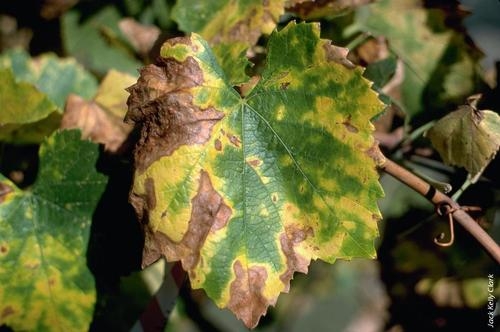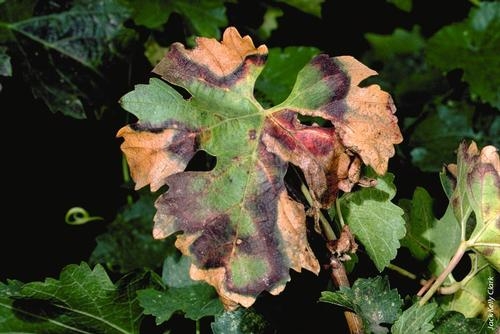Help for the Home Gardener from the Contra Costa Master Gardener Help Desk
Client's Questions and Problems:
Client lives in a condominium/town house complex in central Contra Costa County that permits individual gardens. The client grows both roses and grapes. Immediately adjacent, the Homeowners Association (HOA) maintains a privacy/sound wall covered in ivy (maybe English or Boston ivy). Client brought samples of the plants into the CCMG Help Desk for assistance identifying the plants' problems and what could be done about correcting them. All the plants look distressed with maybe a fungus or possible insect activity, the roses looking somewhat the same and also with black spots on the leaves, and the grape showing signs of distress including discolored leaves and withering. Several days after the client brought samples of the plant problems, and before CCMG could analyze plants for the problems, the client contacted the CCMG Help Desk again to inform HD that after reading an article in California Agriculture (2014, Jan-June, volume 68, page 20), it appeared that the grape leaves may be infected with Pierce's Disease (PD). Based upon the article, the client was concerned that all the grape vines should be removed.
|
Pierce's disease is caused by a strain of the bacteria Xylella fastidiosa, which blocks the water-conducting system of a grapevine, leading to vine death 1 to 5 years after the plant becomes diseased. |
CCMG Help Desk Response:
This is a follow-up to your recent discussion with our MG volunteer, and a follow-up voicemail regarding the discoloration and die-back of your grape leaves and roses.
I. Grapes
You are correct that it looks like your grapes have contracted Pierces' Disease. The photographs you viewed on line and the photos we have viewed in our library certainly seem to confirm the presence of the disease.
I don't know how many grape vines you have, but in case you have more than the one infected plant, here are some of the symptoms to look for:
Symptoms
According to our Pest Management resources:
“In vines that are infected in spring, symptoms of Pierce's disease first appear as water stress in midsummer, caused by blockage of the water-conducting system by the bacteria. The occurrence of the following four symptoms in mid- to late summer indicates the presence of Pierce's disease: (1) leaves become slightly yellow or red along margins in white and red varieties, respectively, and eventually leaf margins dry or die in concentric zones; (2) fruit clusters shrivel or raisin; (3) dried leaves fall leaving the petiole (leaf stem) attached to the cane; and (4) wood on new canes matures irregularly, producing patches of green, surrounded by mature brown bark. Delayed and stunted shoot growth occurs in spring following infection even in vines that did not have obvious symptoms the preceding year.
Leaf symptoms vary among grape varieties. Pinot Noir and Cabernet Sauvignon have highly regular zones of progressive marginal discoloration and drying on blades. In Thompson Seedless, Sylvaner, and Chenin Blanc, the discoloration and scorching may occur in sectors of the leaf rather than along the margins.
Usually only one or two canes will show Pierce's disease symptoms late in the first season of infection, and these may be difficult to notice. Symptoms gradually spread along the cane from the point of infection out towards the end and more slowly towards the base. By mid-season some or all fruit clusters on the infected cane of susceptible varieties may wilt and dry. Tips of canes may die back; roots may also die back. Vines of susceptible varieties deteriorate rapidly after appearance of symptoms. Shoot growth of infected plants becomes progressively weaker as symptoms become more pronounced.
Climatic differences between regions can affect the timing and severity of symptoms, but not the type of symptoms. Hot climates accelerate symptoms because moisture stress is more severe even with adequate soil moisture.
A year after the vines are infected some canes or spurs may fail to bud out, and shoot growth is stunted. New leaves become chlorotic (yellow) between leaf veins, and scorching appears on older leaves. From late April through summer infected vines may grow at a normal rate, but the total new growth is less than that of healthy vines. In late summer leaf burning symptoms reappear.”
Outlook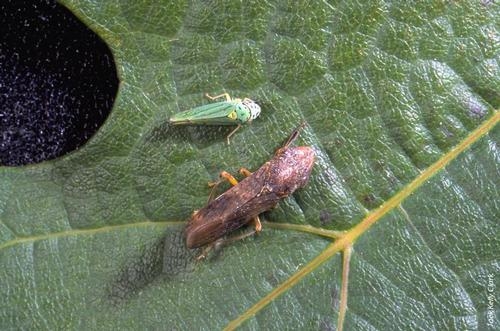
(
(
Management and Control
Control of sharpshooters is not effective, although removal of alternate hosts might help. Some alternate hosts are Bermuda grass, blackberry, and willow. There are many hosts though, so removal of these might not be effective either.
Removing diseased vines as soon as possible when Pierce's disease first appears is critical to help reduce infection of other vines. I would not recommend putting them into your own personal compost bin. If there is a large volume, you might want to consider burning it.
Remove the grapevines as they become unproductive. You could replant with less susceptible cultivars such as 'Sylvaner', 'Thompson Seedless', and 'Ruby Cabernet'.
Certain plants have been identified as preferred breeding hosts for the blue-green sharpshooter (places they will lay eggs). These plants should be avoided if possible.
| Blue-green Sharpshooter Breeding Plants | |
| Blackberry | Fuchsia |
| Eldeberry | Periwinkle |
| Ivy | Geranium |
| Virginia Creeper | Liquidamber |
| Roses | |
As you can see, roses are one of the preferred breeding plants. Although Pierce's Disease doesn't infect roses, it is quite possible given that the sharpshooter prefers roses, and you mentioned that your rose is close to your grapes, that the plant is showing the effects from sharpshooter feeding.
Currently, the only other recommendations with respect to plant selection are to plant conifers, or to establish a non-irrigated xeriphytic (i.e., dry) landscape. These plants should not be attractive to blue-green sharpshooters.
Further information on identifying Pierce's Disease can be found at http://www.ipm.ucdavis.edu/PMG/C302/mt302sppiercedis.html
II. ROSES
From the sample you gave us, and a search of other photos we have, it appears that your rose might be suffering from a couple of things – black spot and the effects of the sharpshooters.
Black Spot Symptoms
According to our resources, “Black spot causes black spots to develop on the upper surface of leaves and succulent stems. The spots have feathery or fiber like margins and no powdery growth on the undersides of leaves. Small black fruiting bodies are often present in spots on upper sides of leaves. Yellow areas develop around the spots. Leaves may drop.”
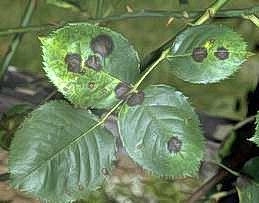
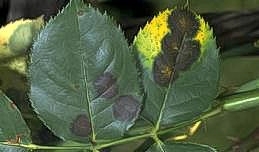
Solutions
The black spot fungus requires free water to reproduce and grow, so leaves should never be allowed to remain wet for more than 7 hours. (When hosing off aphids, do so in the morning so leaves have a chance to dry by midday.) Provide good air circulation around bushes. Remove fallen leaves and other infected material and prune out infected stems during the dormant season. Black spot is usually not a problem during California's dry summers unless overhead sprinklers are used, but the disease can be serious where rainy summers prevail or in cooler areas. Miniature roses are more susceptible than other types, although a few varieties are reliably resistant to all strains of black spot. A combination of bicarbonate of soda plus light horticultural oil can be used to manage black spot (as well as powdery mildew). Use about 4 teaspoons of baking soda per gallon of water with a 1% solution of narrow-range oil. Avoid getting on open blossoms. Neem oil can also be effective. Preventive sprays of fungicides such as triforine or chlorothalonil may also be effective.
A UC IPM Pest Note (free), that will give you some more information on rose pest management can be found on the web at http://www.ipm.ucdavis.edu/PMG/PESTNOTES/pn7463.html
I hope this helps. Thank you again for bringing this problem to us. It was a lot of fun to research.
*********************************************************************
Follow-up: Further Questions and CCMG Help Desk Response:
From the Client:
Thanks for all the helpful information. I see that I'll have my work cut out for me in taking out all the vines, cutting back the roses, and trying not to spread this further. I'll let my HOA know also, because I believe there is an extensive outbreak of something that has affected most of the ivy in the HOA's 30 acres. The ivy within a foot of my grape vines has all died off—and within 10 feet is a Liquidamber tree, and of course geraniums – all of the plants you listed as being breeding plants for the insects. My last question is should I be notifying the county ag department or vector control about this infection?
Follow-up Response: from CCMG Help Desk:
We did some checking and Pierce's disease is not a reportable problem in Contra Costa County, so you don't need to notify anyone.
We also don't think your HOA's ivy dieback is caused by PD, even though ivy is considered a host plant. There are also other insects and diseases that affect ivy, as well as cultural problems. I've been seeing many patches of ivy in the area that appear sunburned and water-stressed and even many drought-adapted plants are having serious problems this year. Here is information from UC that covers pest and diseases in ivy: http://www.ucdavis.edu/PMG/GARDEN/PLANTS/ivy.html. This may help your HOA trouble shoot the ivy problem.
Please feel free to call again if you have more questions.
Contra Costa Master Gardeners' Help Desk
Editor's Note: The Contra Costa Master Gardener Help Desk is available year-round to answer your gardening questions. Except for a few holidays, we're open every week, Monday through Thursday from 9:00 am to Noon at 75 Santa Barbara Road, 2d Floor, Pleasant Hill, CA 94523.
We can also be reached via telephone: (925) 646-6586, email: ccmg@ucanr.edu, and we are on the web at http://ccmg.ucanr.edu/
